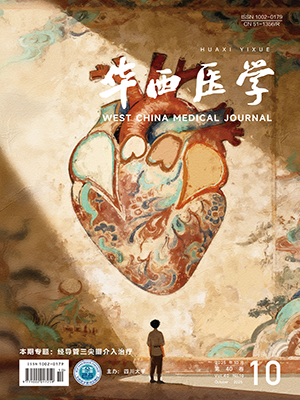| 1. |
张健, 张宇辉, 周蕾. 国家心力衰竭指南 2023(精简版). 中国循环杂志, 2023, 38(12): 1207-1238.
|
| 2. |
GBD 2017 disease and injury incidence and prevalence collaborators. Global, regional, and national incidence, prevalence, and years lived with disability for 354 diseases and injuries for 195 countries and territories, 1990-2017: a systematic analysis for the global burden of disease study 2017. Lancet, 2018, 392(10159): 1789-1858.
|
| 3. |
Horiuchi Y, Asami M, Ide T, et al. Prevalence, characteristics and cardiovascular and non-cardiovascular outcomes in patients with heart failure with supra-normal ejection fraction: insight from the JROADHF study. Eur J Heart Fail, 2023, 25(7): 989-998.
|
| 4. |
Huang J, Yin H, Zhang M, et al. Understanding the economic burden of heart failure in China: impact on disease management and resource utilization. J Med Econ, 2017, 20(5): 549-553.
|
| 5. |
刘杰荣, 罗爱静, 黄攀豪, 等. 基于大数据的单病种住院药品费用合理性筛查实证研究. 医学信息, 2018, 31(7): 10-13.
|
| 6. |
中华人民共和国国家统计局. 中国统计年鉴. 北京: 中国统计出版社, 2023.
|
| 7. |
李雅慧, 袁蕊, 刘雪娇. 全髋关节置换术患者超高住院费用影响因素分析. 中国病案, 2023, 24(8): 72-75.
|
| 8. |
中华中医药学会慢性心力衰竭中医诊疗指南项目组. 慢性心力衰竭中医诊疗指南(2022 年). 中医杂志, 2023, 64(7): 743-756.
|
| 9. |
张彭燕, 刘振球, 樊虹, 等. 限制性立方样条 Cox 比例风险模型在肿瘤预后分析中的应用. 复旦学报(医学版), 2023, 50(2): 280-285.
|
| 10. |
赵德华, 龙小庆, 王继生, 等. 基于限制性立方样条分析抗肿瘤药物与肿瘤患者 DRG 超支之间的相关性. 中国医院药学杂志, 2024, 44(13): 1580-1584.
|
| 11. |
郑昂, 孙树, 王宇航. 药品“零差率”后辽宁省某市乳腺癌患者治疗费用变化分析. 中国卫生统计, 2023, 40(3): 405-407, 411.
|
| 12. |
吴燕婷, 李萍, 吴寒. 药品零加成政策对慢性心力衰竭患者次均住院费用变化影响结构分析. 现代预防医学, 2021, 48(23): 4304-4306, 4344.
|
| 13. |
中国心力衰竭中心联盟专家委员会. 心力衰竭 SGLT2 抑制剂临床应用的中国专家共识. 临床心血管病杂志, 2022, 38(8): 599-605.
|
| 14. |
徐朝辉, 钟逸航, 史天云, 等. 芪附益心方治疗慢性心力衰竭心气虚证患者的临床疗效. 中国实验方剂学杂志, 2023, 29(23): 98-105.
|
| 15. |
许斯, 职晨阳. 2014-2016 年河南省三级甲等医院出院患者平均住院日调查分析. 中国医院, 2018, 22(8): 30-32.
|
| 16. |
于洗河, 降海蕊, 贾欢欢, 等. 吉林省某三甲医院心脑血管疾病患者住院费用影响因素分析. 医学与社会, 2021, 34(2): 12-16.
|
| 17. |
田葳, 张美琪, 王帅飞, 等. 233 例心力衰竭患者住院费用及影响因素分析. 中国病案, 2021, 22(4): 64-67.
|
| 18. |
朱剑, 边素艳, 刘姗姗, 等. 不同类型老年慢性心力衰竭患者心血管及非心血管慢性病负担比较. 中华老年心脑血管病杂志, 2023, 25(3): 255-259.
|
| 19. |
黄宇理, 姚慧强, 张先林, 等. 三甲医院指导下社区慢性心力衰竭患者按分期管理的效果分析. 中华全科医学, 2023, 21(6): 977-980, 1007.
|
| 20. |
孙源, 刘括, 李冰潇, 等. 糖尿病心血管并发症预测模型的构建. 医学新知, 2024, 34(1): 2-13.
|
| 21. |
张欣悦, 李智, 杨平, 等. 临床药师参与重症监护室重症感染患者抗感染治疗效果研究. 药物流行病学杂志, 2024, 33(8): 877-883.
|
| 22. |
顾晓敏, 刘畅. 基于结构变动度及灰色关联的 DRG 付费对妇科肿瘤住院患者住院费用的影响. 中国药师, 2024, 27(4): 622-630.
|




